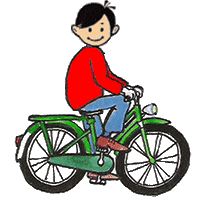

I'm a description. Click to edit me

I'm a description. Click to edit me

I'm a description. Click to edit me

I'm a description. Click to edit me
The Bike is Twice the Price

Beginning Reading Lesson Plan
Rationale: In this lesson teaches children about the long vowel correspondence i_e = /I/. To be able to read, children must learn to recognize the spellings that map word pronunciations. In this lesson children will learn to recognize, spell, and read words containing the spelling i_e. Through a meaningful representation (the bike is twice the price), they will spell and read words containing this spelling in a Letterbox lesson, and read a decodable book that focuses on the correspondence i_e = /I/.
Materials: Materials needed for this lesson is an image of a bike; a cover-up critter; whiteboard or smartboard Elkonin boxes for modeling and individual Elkonin boxes for each student; letter manipulatives for each child: p, r, i, d, e, s, n, l, k, t, m, e, c, b, f, u, o; list of spelling words on whiteboard to read: pride, spine, like, time, kite, ice, tribe, sprite, review words: rub, pop, sit; decodable text: Kite Day at Pine Lake, and the assessment worksheet (attached at bottom).
Procedures:
-
Say: In order to become expert readers we need to learn how to pronounce words and we have a code for that! We have already learned to read short vowel words with i, like icky, and today we are going to learn about long I and the silent e signal that is used to make I say its name, /I/. When I say /I/ think of someone buying a bike saying, “The Bike is Twice the Price!“ [show graphic image].
-
Say: Before we learn about the spelling of /I/, we need to listen for it. When I listen for /I/ in words, I hear i say its name /I/ and my tongue hits the back of my teeth to say /I/. [Make vocal gesture for /I/.] I’ll go first and show you: five. I heard i say its name and I felt my tongue hit the back of my teeth. In five, there is a long i. Now I’m going to see if it’s in sticky. Hmm, I didn’t hear i say its name and my tongue didn’t hit the back of my teeth. Okay, now your turn. If you hear /I/ say, “The Bike is Twice the Price!” If you don’t hear /I/ say, “That’s not it!” Is it like, fork, kite, boat, lips, and rice? [Have children hold up a finger when they feel their tongue hit their teeth and /I/ say its name.]
-
Say: Let’s look at the spelling of /I/ that we are going to learn today. One-way to spell /I/ is with the letter i and a signal e at the end of the word to tell me to say I’s name. [Write i_e on the board.] The blank line means there is a consonant after i, and at the end of the word there is a little silent e signal. What if I want to spell the word pride? “ She takes a lot of pride in her school work." In this sentence a pride means to take ownership of something. To spell pride in letterboxes, first I need to know how many phonemes there are in the word. So I stretch it out and count: /p//r//I//d/. I need 4 boxes. I heard /I/ right before the /d/ so I’m going to put an i in the 3rd box and the silent e signal goes on the outside of the last box. The word starts with /p/, that’s easy; I need an p. Now it gets a little tricky so I’m going to say it slowly, /p//r//I//d/. I think I heard /r/ growling so I’ll put a r right after the p. Next is /I/ and I have one empty box now. [Point to letters in boxes when stretching out the word: /p//r//I//d/.] The missing one is /d/ = d.
-
Say: Now you are going to spell some words in letterboxes. We will start easy with two boxes for ice. Ice is cold, frozen water; “I like to put ice in my water to keep it cold.” What should go in the first box? [Respond to children’s answers]. What goes in the second box? What about silent e, did you remember to put it outside the boxes? As I walk around the room, I will check your spelling. [Observe progress.] For the next word we need three letterboxes. Listen for the beginning sound that goes in the first box. Then listen for /I/ and don’t forget to put the silent e outside the boxes. Here’s the word: time, I was on time to the doctor today, time. [Allow children to spell words.] Let’s check our work. Look to see how I spell it in my letterboxes t – i – m – e and see if you’ve spelled it like I did. We’re going to do another with three boxes: like; I like chocolate ice cream, like. [Have volunteer spell it in the letterbox on the front board for children to check their work. Repeat this step for each new word.] Next word. Listen to see if this word has /I/ in it before you spell it: fork; I need a fork for dinner tonight. Do you need a silent e for this word? Why not? Yes, because we don’t hear i say its name in this word. We spell it with short vowel o. [get a volunteer to spell it on the front board.] Did you remember to spell /k/ with a k? Now let’s try 4 phonemes: tribe; the Indians lived in a tribe together. This is our last one and then we will be done with spelling, and now you need five boxes: sprite; My favorite soft drink is sprite. Remember to stretch it out to get this tough word.
-
Say: Next you are going to get to read the words you have spelled, but first I’ll show you how I would read a tough word. [Display poster with pride on the top and model reading the word.] First off I see that there is a silent e on the end; this is my clue that the vowel will say its name. There’s the vowel i. It must say /I/. I’m going to use a cover-up to get the first part. [Uncover and blend sequentially before the vowel, then blend with the vowel.] /p/ = /p/ + /r/ = /pr/. Now I’m going to blend that with /I/ = /prI/. Now all I need is the end, /d/ = /prId/. Pride; that’s it. Now you try it, everyone together. [Have children read words in unison. Afterwards, call on individuals to read one word on the list until everyone has had a turn.]
-
Say: You all have done a terrific job and reading words with our new spelling for /I/: i_e. Now we are going to read a book called Kite Day at Pine Lake. This is a story of a children who have kites to fly. Each child has a different kite. Bob doesn’t have a kite. Let’s pair up and take turns reading Kite Day at Pine Lake to find out if Bob gets a kite. [Children pair up and take turns reading alternate pages each while teacher walks around the room monitoring progress. After individual paired reading, the class rereads Kite Day at Pine Lake aloud together, and stops between page turns to discuss the plot.]
-
Say: That was a fun story. What happened to Bob and his kite? Yes, all the other children helped Bob make a kite to fly. Who helped Bob make his kite? Yes, Jan and Jeff. Before we finish up with our lesson about one way to spell /I/ = i_e, I want to see how you can solve a reading problem. On this worksheet, we have some words missing. Your job is to look in the box of word choices, and decide which i_e word rhyme together, and then you will write them on the line. First try reading all the words in the box, then choose the words that best fit together. Say them out loud to make sure your answers make sense.
Resources:
Pickett, Shelby, Twice the Spice is Nice! http://slp0024.wixsite.com/shelbylynnepickett/beginning-reading-design
Murray, Geri, Oh, I Didn’t Know!
Assessment worksheet: http://www.tlsbooks.com/pdf/longisound1.pdf
Clip Art: http://www.wilsoninfo.com/bicycle/boy-riding-bike.gif
p
r
i
d
e